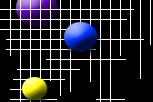A
plane is a boundless
surface in
space. It has length, like a
line; it also has width, but not thickness. A plane is denoted by writing "plane P", or just writing "P". On paper, a plane looks
something like this:
There are two ways to form a plane. First, a plane can be formed by three
noncolinear points. Any number of
colinear points form one line, but such a line can lie in an infinite number of distinct planes. See below how different planes can
contain the same line.

Figure 3.2: Many different planes can contain the same line
It takes a third, noncolinear
point to form a specific plane. This point fixes the plane in position. The situation is something like a door being shut.
Before the door is shut, it swings on hinges, which form a line. The door (a plane) can be opened to an infinite number of
different positions, maybe just cracked a few inches, or maybe wide open (figures a, b in the diagram below). When the door
is shut however, the wall on the other
side of the hinges acts as the noncolinear third point and holds the door in place. At this point, the door represents one distinct
plane (figure c).
The second way to form a plane is with a line and a point in that line. There are just two conditions.
1) the line must be
perpendicular to the plane being formed (for an explanation of this concept, see
Geometric Surfaces, Lines and Planes); 2) the point in the line must also be in the plane being formed. Given a line, a point in that line, and these conditions,
a plane is determined.
When points lie in the same plane, they are called
coplanar. When points lie in different planes, they are called
noncoplanar. The concept is much like that of colinearity.
As previously mentioned, a plane has no thickness. Remember that though the diagrams shown here make
it appear otherwise, a plane also has no limits: it is an endless surface in space. Most of the geometry you will see in this
guide will deal with plane geometry. We will deal with "flat" shapes that lie in a plane, and therefore have no thickness.
All of the points in such geometric figures are coplanar.

